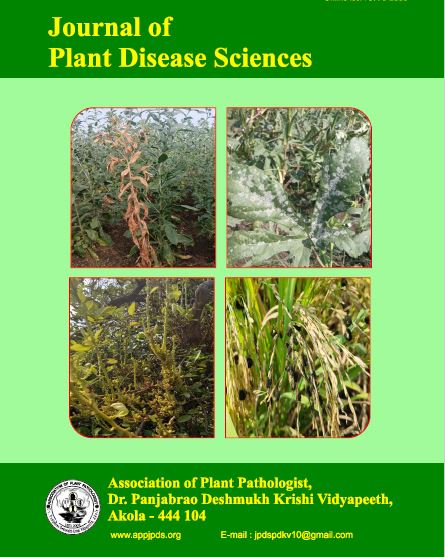ASSOCIATION OF DIFFERENT GRAIN MOLD FUNGAL FLORA AT DIFFERENT CROP STAGES OF KHARIF SORGHUM
DOI:
https://doi.org/10.48165/jpds.2024.1901.16Keywords:
Crop stages, Kharif sorghum, Fusarium spp, Curvularia lunata, Association, Grain moldAbstract
In India, Maharashtra, Karnataka, Andhra Pradesh, Madhya Pradesh, Gujarat and Tamil Nadu are major sorghum growing states. In Maharashtra sorghum crop is cultivated for grain and fodder purpose. Among the several sorghum diseases occurring in various parts of Maharashtra, majority of them are reported to be seed borne. The most destructive sorghum diseases reported are fungal diseases. Grain mold fungi of hybrid varieties of sorghum at their maturity, which is coincide with rain in the September-October months is important. Association of fungal flora in 28 sorghum hybrid/varieties assessed at three different stages of crop tested by rolled paper towel method and results revealed that association of fungal flora varied at different stages in respective hybrid /varieties. Highest association of Fusarium spp. and Curvularia spp. observed in respective hybrid/variety at maturity stages. At crop maturity stage results revealed that association of total moldy fungi spp. (46.50 to 91.00 %).
References
Ambekar, S. S., M. Y. Kamatar, K. Ganesamurthy, R. B. Ghorade, U. Saxena, P. Chand and et. al., 2011: Genetic enhancement of Sorghum (Sorghum bicolor (L) Moench) for grain mould resistance: II. breeding for grain mould resistance. Crop Protect., 30, 759–764. doi : 10.1016/j.cropro.2010.06.024
Anonymous, 2015 : Director Economics and Statistics Department of Agriculture and Co- operation.
Bandyopadhyay, R., D. R. Butler, A. Chandrashekar, R. Kanaka and S. S. Navi, 2000 : Biology, epidemiology, and management of sorghum grain mold. In : Technical and Institutional Options for Sorghum Grain Mold Management, eds Chandrashekar A., Bandyopadhyay R., Hall A. J. (Patancheru: ICRISAT;), 34–51.
Das, I. K., C. Aruna and V. A. Tonapi, 2020 : Sorghum Grain Mold. Hyderabad: ICAR-Indian Institute of Millets Research, 86.
Das, I. K. and P. G. Padmaja, 2016. Biotic Stress Resistance in Millets 2nd Edi., Academic Press : pp 246.
Forbes, G.A.; R. Bandyopadhyay and G. Garcia, 1992: A review of sorghum grain mold. In Sorghum and millets diseases: A Second World Review (de Milliano, W.A.J. Frederiksen, RA. and Bengston, G.
D. edts.), ICRISAT, Patancheru, India, pp: 265-272.
Frederiksen, R. A., L. L. Castor and D. T. Rosenow, 1982 : Grain moldsmallseed and head blight : The Fusarium connection in sorghum. Proc.37thAnn. Corn and Sorghum Conf. :26-36.
Gaikwad, M.S., S.S. Wodibhasme, S.B. Atale and P.W. Deshmukh, 2000: Effect of delayed harvesting on infestation of grain molds on sorghum. Paper presented in National Seminar on Sorghum under different Agro-ecological systems and its Industrial Utilization, organized by Vansantrao Naik Smruti Pratishthan, Pusad and Dr. Punjabrao Deshmukh Krishi Vidyapeeth, Akola at College of Agriculture, Nagpur during 1-2 March, 2000 : pp 40-41.
Garud,T.B.; B.M. Shinde, Syed Ismail and E.N. Aglave, 1998 : Effect of delayed harvesting on grain mold development in sorghum. International Sorghum and Millet Newsletter, 41:54.
Kumar, L.S., H.S Prakash, H.S. Shetty and N.G. Mallishi, 1991: Influence of seed mycoflora and harvesting conditions on mining, popping and melting qualities of sorghum (Sorghum biocolar). J. Sci. Food Agri., 55(4): 617-625
Magar, Sunita J. and B. P. Kurundkar, 2005: Effect of time of harvest on sorghum grain mold. Indian Phytopath., 58 (4). 54-56.
Somani, R. B., 1992: Studies on biochemical status of resistant and susceptible Sorghum bicolor cultivarsagainstgrain molds. ISMN, 34:24. Sundaram, N. V., L. T. Palmer, K. Nagaranjan, and J.M. Pre Scott, 1972 : Disease of sorghum and millet in India. Plant Disease Reporter, 56 :740-743.
Thakur, R. P.; V. P. Rao, S. S. Navi, T. B. Garud, G. D. Agarkar and B. Bhat, 2003: Sorghum grain mold variability in fungal complex. Int. Sorghum and Millets Newsletter, 44: 104-108.130.

